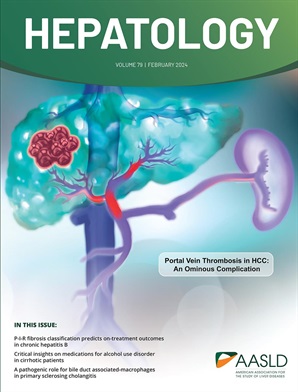在肝纤维化过程中,胆道YB-1/GLI2轴通过SPP1/Integrin αvβ1信号通路促进小管反应,促进肝星状细胞活化
IF 12.9
1区 医学
Q1 GASTROENTEROLOGY & HEPATOLOGY
引用次数: 0
摘要
背景,目的:越来越多的证据表明,导管反应细胞(DRCs)介导的导管反应(DR)加速了肝星状细胞(hsc)的激活,并有助于肝纤维化的发生。先前的研究表明Y-box结合蛋白1 (YB-1)促进DRC扩展。本研究旨在探讨yb -1介导DR的机制及其在HSC活化中的作用。的方法,结果:YB-1在人损伤肝DRCs中高表达。将CK19CreERT小鼠与YB-1flox/flox小鼠杂交,生成dc特异性YB-1敲除小鼠。drc特异性YB-1缺失可减轻3,5-甲氧基羰基-1,4-二氢碰撞碱(DDC)喂养和四氯化碳(CCl4)处理引起的DR和肝损伤。转录组学分析、染色质免疫沉淀和荧光素酶分析显示,YB-1转录调节GLI2并促进DRC增殖。药理抑制GLI2可显著减轻DDC和CCl4小鼠模型的DR和肝纤维化。Transwell共培养实验表明,YB-1/GLI2轴在DRCs中驱动HSC活化。液相色谱-质谱联用生物信息学分析发现,分泌磷酸化蛋白1 (SPP1)是连接YB-1/ gli2介导的DR与HSC激活的关键分子。SPP1在人损伤肝脏中高表达,并与整合素相互作用。dc特异性敲除YB-1可减少小鼠纤维化肝脏中SPP1和整合素αvβ1受体的共定位。阻断造血干细胞中整合素αvβ1受体抑制其活化,这是由dc衍生的SPP1诱导的。结论:YB-1/GLI2轴促进DRC增殖和SPP1分泌,通过整合素αvβ1受体促进HSC活化。本研究强调了YB-1/GLI2/SPP1信号通路作为肝纤维化治疗干预的潜在靶点。本文章由计算机程序翻译,如有差异,请以英文原文为准。
Biliary YB-1/GLI2 axis facilitates ductular reaction and promotes hepatic stellate cell activation via SPP1/Integrin αvβ1 signaling during liver fibrogenesis
Background & Aims: Emerging evidence suggests that ductular reactive cells (DRCs)-mediated ductular reaction (DR) accelerates the activation of hepatic stellate cells (HSCs) and contributes to liver fibrogenesis. Previous studies implicated Y-box binding protein 1 (YB-1) in promoting DRC expansion. This study aims to investigate the mechanisms underlying YB-1-mediated DR and its role in HSC activation. Approach & Results: YB-1 was highly expressed in DRCs in human injured livers. CK19CreERT mice were crossed with YB-1flox/flox mice to generate DRC-specific YB-1 knockout mice. DRC-specific YB-1 deletion attenuated DR and liver injury induced by 3,5-methoxycarbonyl-1,4-dihydrocollidine (DDC) feeding and carbon tetrachloride (CCl4 ) treatment. Transcriptomic analyses, along with chromatin immunoprecipitation and luciferase assays, revealed that YB-1 transcriptionally regulated GLI2 and promoted DRC proliferation. Pharmacological inhibition of GLI2 significantly attenuated DR and liver fibrosis in DDC and CCl4 mouse models. Transwell co-culture assay indicated that YB-1/GLI2 axis in DRCs drived HSC activation. Liquid chromatography-mass spectrometry combined with bioinformatic analyses identified secreted phosphoprotein 1 (SPP1) as the key molecule linking YB-1/GLI2-mediated DR to HSC activation. SPP1 was highly expressed in human injured livers and interacted with integrins. DRC-specific YB-1 knockout decreased the co-localization of SPP1 and integrin αvβ1 receptors in mouse fibrotic livers. Blocking integrin αvβ1 receptors in HSCs suppressed their activation, which was induced by DRC-derived SPP1. Conclusions: YB-1/GLI2 axis promotes DRC proliferation and SPP1 secretion, which facilitates HSC activation through integrin αvβ1 receptors. This study highlights the YB-1/GLI2/SPP1 signaling pathway as a potential target for therapeutic intervention in liver fibrosis.
求助全文
通过发布文献求助,成功后即可免费获取论文全文。
去求助
来源期刊

Hepatology
医学-胃肠肝病学
CiteScore
27.50
自引率
3.70%
发文量
609
审稿时长
1 months
期刊介绍:
HEPATOLOGY is recognized as the leading publication in the field of liver disease. It features original, peer-reviewed articles covering various aspects of liver structure, function, and disease. The journal's distinguished Editorial Board carefully selects the best articles each month, focusing on topics including immunology, chronic hepatitis, viral hepatitis, cirrhosis, genetic and metabolic liver diseases, liver cancer, and drug metabolism.
 求助内容:
求助内容: 应助结果提醒方式:
应助结果提醒方式:


